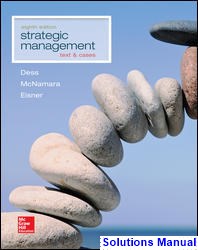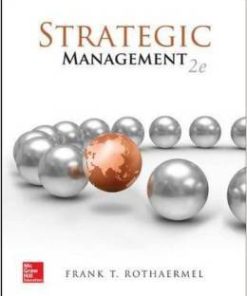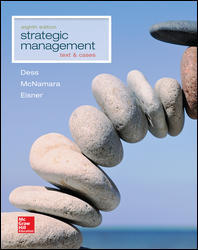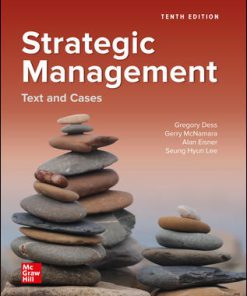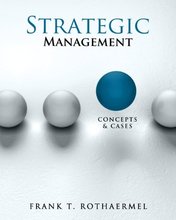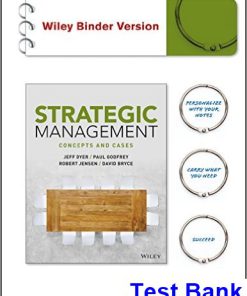Strategic Management Text and Cases Dess 7th Edition Test Bank
$35.00 Original price was: $35.00.$26.50Current price is: $26.50.
Strategic Management Text and Cases Dess 7th Edition Test Bank
Strategic Management Text and Cases Dess 7th Edition Test Bank
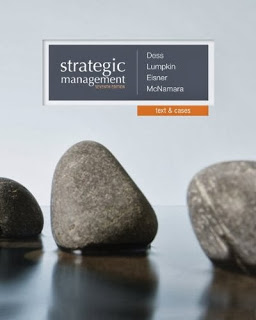
Product details:
- ISBN-10 : 9780077862527
- ISBN-13 : 978-0077862527
- Author: Alan B. Eisner
Strategic Management: Text and Cases, Seventh Edition, written by the well respected authors Dess/Lumpkin/Eisner/McNamara provide solid treatment of traditional topics in strategic management as well as thorough coverage of contemporary topics such intellectual assets, entrepreneurship, innovation, knowledge management, internet strategies, crowdsourcing, environmental sustainability. The accessible writing style and wealth of new and updated illustrations, which clarify the most difficult topics, make this title an excellent resource for your students.
The new case selections emphasise variety, currency, and familiar company names. The cases are up-to-date in terms of both financial data and strategic issues. This group of cases gives both instructors and students unparalleled quality and variety. Based on consistent reviewer
People also search:
Strategic Management Text and Cases
Strategic Management Text and Cases Dess Lumpkin Eisner
Strategic Management Text and Cases Dess Lumpkin Eisner 7th
Strategic Management Text and Cases Dess Lumpkin Eisner 7th Test Bank
Strategic Management Text and Cases Dess 7th Edition Test Bank
Description:
Chapter 1
1. The success Apple, Inc. achieved over the past decade was a direct result of the creative and forceful leadership of its late CEO, Steve Jobs. According to the text, this would be an example of the “romantic” perspective of leadership.
True False
2. Strategic management consists of the analyses, decisions, and actions an organization undertakes in order to create and sustain competitive advantages.
True False
3. The three interrelated and principal activities of strategic management are: strategy analysis, strategy formulation, and strategy implementation.
True False
4. According to the textbook, strategic management does not consist of the analyses that an organization undertakes in order to create and sustain competitive advantages.
True False
5. Management innovations such as total quality, just-in-time, benchmarking, business process reengineering, and outsourcing are important, but not enough for building sustainable competitive advantage.
True False
6. Strategic management recognizes the trade-offs between effectiveness and efficiency.
True False
7. According to Henry Mintzberg, a management scholar, most firms realize their original intended strategy.
True False
8. According to the text, formulating strategy includes taking into consideration strategy at the business, corporate, and international levels.
True False
9. Business-level strategy focuses on (1) what businesses to compete in, and (2) the management of the business portfolio to create synergy among its businesses.
True False
10. Corporate-level strategy addresses how firms compete and outperform their rivals as well as achieve and sustain competitive advantages.
True False
11. Effective leadership can play a large role in fostering corporate entrepreneurship. Corporate entrepreneurship can have a very positive impact on the bottom line of a firm.
True False
12. The three primary participants in corporate governance are: (1) the shareholders, (2) the management (led by the chief executive officer), and (3) the employees.
True False
13. Decisions by boards of directors are always consistent with shareholder interests.
True False
14. Former Chrysler vice chairman Robert Lutz observed that companies exist to serve the shareholder and create shareholder value. He insisted that the only person who owns the company is the person who paid good money for it. This is an example of a symbiotic approach to stakeholder management.
True False
15. Stockholders in a company are the only individuals with an interest in the financial performance of the company.
True False
16. Stockholders, employees, and the community-at-large are among the stakeholders of a firm.
True False
17. Symbiosis is the ability to recognize interdependencies among the interests of multiple stakeholders within and outside an organization.
True False
18. Procter and Gamble developed a laundry detergent compaction technique that appeals to consumers, retailers, shipping and wholesalers, and environmentalists. This is an example of stakeholder symbiosis.
True False
19. Social responsibility is the idea that organizations are not only accountable to stockholders but also to the community-at-large.
True False
20. The concept of shared value redefines the purpose of the corporation as creating shared value in order to create a more even distribution of the profits to all employees, not just top level executives.
True False
21. Shell, NEC, and Procter and Gamble have been measuring their performance according to what has been called a triple bottom line. This technique involves an assessment of financial, social, and environmental performance.
True False
22. The strategic management process should be addressed only by top-level executives. Mid-level and low-level employees are best equipped to implement the strategies of the organization.
True False
23. The vision of an organization is the top level of its hierarchy of organizational goals. The vision statement should be massively inspiring, overarching, and long term.
True False
24. Strategic objectives are more specific than vision statements.
True False
25. According to the text, a mission statement is an overarching statement that is massively inspiring, long term, and only discusses the purpose of the company.
True False
26. A mission statement encompasses both the purpose of the organization as well as its basis of competition, and the basis of its competitive advantage.
True False
27. Some excellent examples of mission statements are: To be the happiest place on earth (Disneyland) and Restoring patients to full life (Medtronic).
True False
28. Strategic objectives should be measurable, specific, appropriate, and realistic, but not constrained by time deadlines.
True False
29. Much research has supported the notion that individuals work much harder when they are asked to do their best rather than when they are striving toward a specific goal.
True False
30. Objectives in organizations should be clear, stated, and known by employees throughout the organization.
True False
31. Strategic management should only include short-term objectives. Long-term objectives are covered in the vision statement of the organization.
True False
32. Organizational goals and objectives should be vague in order to allow for changes in strategy.
True False
33. The text addresses two perspectives of leadership as well as their implications. These two perspectives are:
A. romantic and unromantic
B. romantic and internal control
C. external control and unromantic
D. romantic and external control
34. A CEO made a lot of mistakes in assessing the market and the competitive conditions and improperly redesigning the organization into numerous business units. Such errors led to significant performance declines. According to the text, this example illustrates the __________ perspective of leadership.
A. external control
B. romantic
C. internal mechanism
D. operational
35. According to the text, the strategic management process entails three ongoing processes:
A. analyses, actions, and synthesis
B. analyses, decisions, and actions
C. analyses, evaluation, and critique
D. analyses, synthesis, and antithesis
36. Management innovations such as total quality, benchmarking, and business process reengineering cannot lead to sustainable competitive advantage because:
A. companies that have implemented these techniques have lost money
B. there is no proof that these techniques work
C. they cost too much money and effort to implement
D. every company is trying to implement them and hence it does not make a company different from others
37. The organizational versus the individual rationality perspective suggests that:
A. what is good for a functional area is always good for the organization
B. what is good for the organization is always good for a functional area
C. what is best for a functional area may not be best for the organization
D. the incremental perspective may be best for functional areas while the “rational” perspective may be best for the organization
38. The four key attributes of strategic management include the idea that:
A. strategy must be directed toward overall organizational goals and objectives
B. strategy must be focused on long-term objectives
C. strategy must be focused on one specific area of an organization
D. strategy must focus on competitor strengths
39. The four key attributes of strategic management include all of the following EXCEPT:
A. including multiple stakeholder interests in decision making
B. incorporating both short-term and long-term perspectives
C. recognizing the trade-offs between effectiveness and efficiency
D. emphasis on the attainment of short-term objectives
40. Effectiveness is often defined as:
A. doing things right
B. stakeholder satisfaction
C. doing the right thing
D. productivity enhancement
41. All of the following are ambidextrous behaviors EXCEPT:
A. taking initiative and being alert to opportunities beyond the confines of one’s own job
B. being cooperative and seeking opportunities to combine one’s efforts with others
C. intensely focusing on the responsibilities of one individual and maximizing the output of the department in the organization in which that individual works
D. being brokers, always looking to build internal linkages
42. According to Henry Mintzberg, the realized strategies of a firm:
A. are a combination of deliberate and emergent strategies
B. are a combination of deliberate and differentiation strategies
C. must be based on the strategic plan of the company
D. must be kept confidential for competitive reasons
43. According to Henry Mintzberg, decisions following from the strategic analysis of the firm are its:
A. emergent strategy
B. deliberate strategy
C. intended strategy
D. realized strategy
44. __________ may be considered the advance work that must be done in order to effectively formulate and implement strategies.
A. Goal setting
B. Corporate entrepreneurship
C. Strategy analysis
D. Organizational design
45. __________ involves ensuring proper strategic controls and organizational designs.
A. Corporate governance
B. Corporate-level strategy
C. Strategy implementation
D. Business-level strategy
46. The three participants in corporate governance are:
A. the shareholders, board of directors, and employees
B. the shareholders, labor unions, and employees
C. the shareholders, board of directors, and management
D. the shareholders, banks and lending institutions, and management
47. While working to prioritize and fulfill their responsibilities, members of the board of directors of an organization should:
A. represent their own interests
B. represent the interests of the shareholders
C. direct all actions of the CEO
D. emphasize the importance of short-term goals
48. Members of boards of directors are:
A. appointed by the Securities and Exchange Commission
B. elected by the shareholders as their representatives
C. elected by the public
D. only allowed to serve one term of four years
You may also like…
Solution Manual
Solution Manual and Case Solutions for Strategic Management Text and Cases 6th Edition by Dess
Solution Manual
Solution Manual




